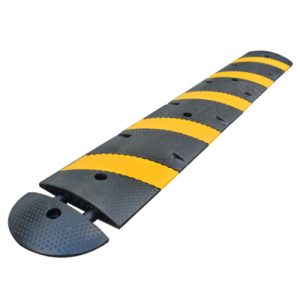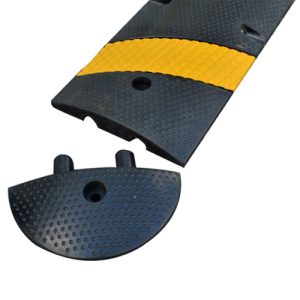Speed bumps are designed to reduce vehicle speed and reduce collisions between vehicles. They are used in residential areas to prevent or slow down traffic.
In cities where there is a high volume of traffic, speed bumps can increase pedestrian safety. They are also useful in urban settings. Many cities in Connecticut have installed speed bumps.
Common uses for speed bumps
The most common uses for speed bumps are on low-speed roads. The maximum comfortable speed to cross a speed bump is five miles per hour.
Therefore, they are appropriate for parking lots and private roads with lower-speed limits. The other most common application for a bump is on residential streets with speed limits of 25 miles per hour.
If you need a higher-speed bump, you should install the corresponding speed hump.
Another important use for speed bumps is reducing accidents. They can make pedestrians safer. Children are particularly susceptible to injuries and accidents, and they are disproportionately affected by automobile crashes.
A speed bump can decrease the risk of injury or death by up to 53%. If you’re planning a road project, speed bumps are an excellent solution. However, they are not always the best option.
Speed bumps vary in height and length
A bumps’ travel length is typically three to 20 feet. A longer bump reduces speed by about five miles per hour. A shorter bump can reduce a vehicle’s speed by as much as ten miles per hour. Often, speed bumps are placed mid-block between intersections, so they slow traffic and slow emergency vehicles down.
Unlike the speed bumps, speed humps are a form of road surface with a stepped surface. The bumps are usually positioned between three and twenty feet apart.
In a pinch-point, the height of the bump is four to eight feet. If you want to slow a vehicle down, you can use a bump between two and ten feet. If you’re traveling at a slower pace, a rumble strip is a better choice.
| SKU | Description | Length | Height | Width | Weight |
|---|---|---|---|---|---|
| SB206FT | 6 Ft Speed Bump (1) 6′ Section With no End Caps | 72″ | 2″ | 12″ | 48.40 |
| SB207FT | 7 Ft Speed Bump (1) 6′ Section + (2) End Caps | 86″ | 2″ | 12″ | 55.40 |
| SB213FT | Single Lane 12 Ft Speed Bump (2) 6′ Section With no End Caps | 144″ | 2″ | 12″ | 96.80 |
| SB219FT | Double lane 19 Ft Speed Bump (3) 6′ Section + (2) End Caps | 230″ | 2″ | 12″ | 152.20 |
| SB225FT | 25 Ft Speed Bump (4) 6′ Section + (2) End Caps | 302″ | 2″ | 12″ | 200.60 |
| SB2ECAP | End cap | 7′ | 2′ | 12′ | 3.50 |
| SKU | Description | Length | Height | Width | Weight |
|---|---|---|---|---|---|
| SB3039I | 39″ Speed Bump (1) 39″ Section With no End Caps | 39″ | 2″ | 13.7″ | 36.20 |
| SB3117I | 117″ Single Lane Speed Bump (3) 39″ Sections With no End Caps | 117″ | 2″ | 13.7″ | 108.60 |
| SB3137I | 137″ Single Lane Speed Bump (3) 39″ Sections + (2) End Caps | 137″ | 2″ | 13.7″ | 124.20 |
| SB3234I | 234″ Double lane Speed Bump (6) 39″ Sections With no End Caps | 234″ | 2″ | 13.7″ | 217.20 |
| SB3254I-2 | 254″ Double Lane Speed Bump (6) 39″ Sections + (2) End Caps | 254″ | 2″ | 13.7″ | 232.80 |
| SB3ECAP-2 | End cap | 10″ | 2″ | 13.7″ | 7.80 |
| SKU | Description | Length | Height | Width | Weight |
|---|---|---|---|---|---|
| SH1018I | 18.75″ Speed Bump (1) 18.75″ Section with no End Caps | 18.75″ | 1.25″ | 2″ | 22.20 |
| SH1112I | 112.5″ Single Lane Speed Bump (6) 18.75″ Sections with no End Caps | 112.5″ | 1.25″ | 2″ | 133.20 |
| SH1128I | 10 Ft Single Lane Speed Bump (6) 18.75″ Sections + (2) End Caps | 128.5 | 1.25″ | 2″ | 148.80 |
| SH1225I | 225″ Double Lane Speed Bump (12) 18.75″ Sections with no End Caps | 225″ | 1.25″ | 2″ | 266.40 |
| SH1241I | 20 Ft Double Lane Speed Bump (12) 18.75″ Sections + (2) End Caps | 241″ | 1.25″ | 2″ | 282.00 |
| SH1ECAL | LEFT End Cap | 8″ | 1.25″ | 2′ | 7.80 |
| SH1ECAR | RIGHT End Cap | 8″ | 1.25″ | 2′ | 7.80 |
| SKU | Description | Length | Height | Width | Weight |
|---|---|---|---|---|---|
| SH2019I | 19.75″ Speed Bump (1) 19.75″ Section With no End Caps | 19.75″ | 2″ | 3″ | 48.00 |
| SH2121I | 10 Ft Single Lane Speed Bump (5) 19.75″ Sections + (2) End Caps | 121.75″ | 2″ | 3″ | 273.00 |
| SH2240I | 20 Ft Double Lane Speed Bump (11) 19.75″ + (2) End Caps | 240″ | 2″ | 3″ | 561.00 |
| SH2ECAL | LEFT End cap | 11.5″ | 2″ | 3′ | 16.00 |
| SH2ECAR | RIGHT End cap | 11.5″ | 2″ | 3′ | 16.00 |
What is a speed hump?
It’s made of plastic and is usually used in residential areas. In addition, they are often located at the mid-block of a highway or parking lot. The bumps slow traffic down and reduce collisions.
They are often placed at the end of a driveway. Whether you live in the city or on a rural street, a speed bump is an effective tool in slowing down traffic.
The design of a speed bump can affect pedestrians. The most common area for them is a private road or parking lot. They can be used in cities to slow down traffic in neighborhoods.
Aside from reducing vehicle speeds, speed bumps can improve the safety of pedestrians. If you live in an area with a high number of pedestrians, a speed bumps are an excellent way to slow traffic.
A speed hump is not a speed bump. It is a type of bump. Its use is for slowing traffic. They are placed in public areas where the goal is to reduce speed.
Some people believe that they are harmful to the environment. This isn’t true. Instead, they can cause harm to the environment. Then, you might want to install the speed bumps for safe driving.
These bumps are designed to slow down traffic in a school zone. They can be installed in parking lots and on private roads.
Although they are not as common as a real speed bump, they are still effective. They reduce the speed of cars to less than five miles per hour. They also make pedestrians safer. When installed correctly, they can improve the safety of pedestrians and motorists.
Final words
A speed hump is similar to a speed bump, except that it is higher. Its height and length are determined by the materials used in the bumps. This is an effective way to prevent pedestrians from being hit by a car that has gone through a bump.
A bump is a small, vertical, parabolic traffic calming device intended to reduce traffic speeds on low-speed roads. It is used in parking lots to slow traffic and reduce the speed of vehicles in the area. The bumps are 1.25 to 2 inches high and 12 to 14 feet wide. The length of the ramp can vary from six to eighteen inches.




